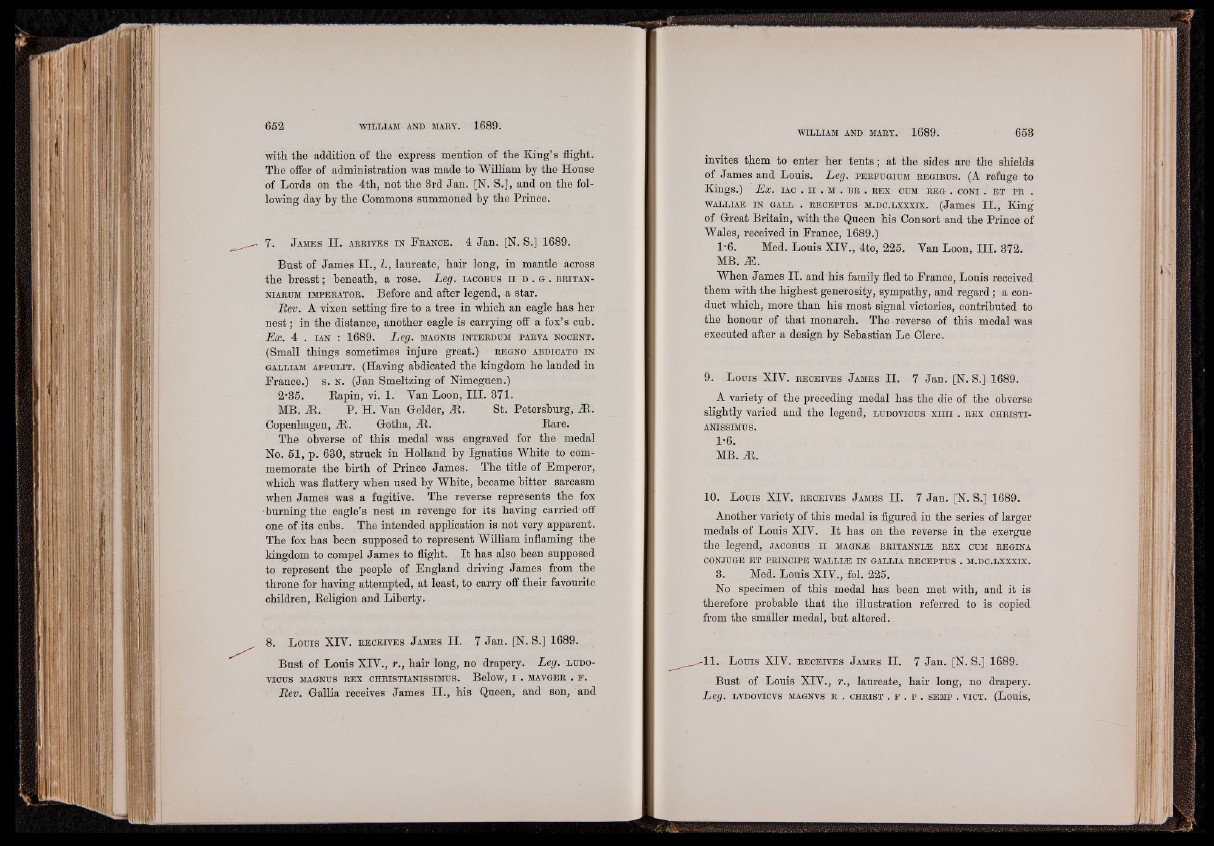
with the addition of the express mention of the King’s flight.
The offer of administration was made to William by the House
of Lords on the 4th, not the 3rd Jan. [N. S.], and on the following
day by the Commons summoned by the Prince.
7. J am e s II. a r r iv e s in F r a n c e . 4 Jan. [N. S.] 1689.
Bust of James II., I., laureate, hair long, in mantle across
the breast; beneath, a rose. Leg. ia c o bu s i i d . g . b r it a n -
n ia r um im p e r a t o r . Before and after leigend, a star.
Rev. A vixen setting fire to a tree in which an eagle has her
n e st; in the distance, another eagle is carrying off a fox’s cub.
Ex. 4 . ia n : 1689. Leg. m ag n is in t e r d u m parva n o c e n t .
(Small things sometimes injure great.) r e g n o abdicato in
gat,t,tam a p p u l it . (Having abdicated the kingdom he landed in
France.) s. n . (Jan Smeltzing of Nimeguen.)
2*35. Bapin, vi. 1. Van Loon, III. 371.
MB. At. P. H. Van Gelder, At. St. Petersburg, At.
Copenhagen, At. Gotha, At. Bare.
The obverse of this medal was engraved for the medal
No. 51, p. 630, struck in Holland by Ignatius White to commemorate
the birth of Prince James. The title of Emperor,
which was flattery when used by White, became bitter sarcasm
when James was a fugitive. The reverse represents the fox
burning the eagle’s nest in revenge for its having carried off
one of its cubs. The intended application is not very apparent.
The fox has been supposed to represent William inflaming the
kingdom to compel James to flight. It has also been supposed
to represent the people of England driving James from the
throne for having attempted, at least, to carry off their favourite
children, Beligion and Liberty.
8. Louis XIV. r e c e iv e s J am e s II. 7 Jan. [N. S.] 1689.
Bust of Louis XIV., r., hair long, no drapery. Leg. l u d o -
VICUS MAGNUS REX CHRISTIANISSIMUS. Below, I . MAVGER . F.
Rev. Gallia receives James II., his Queen, and son, and
invites tbem to enter her tents; at the sides are the shields
of James and Louis. Leg. p e r f u g iu m r e g ib u s . (A refuge to
Kings.) Ex. IAC . I I . M . BR . REX CUM REG . CONI . ET PR .
w a l l ia e in ga l l . r e c e p t u s m .dc .lx x x ix . (James II., King
of Great Britain, with the Queen his Consort and the Prince of
Wales, received in France, 1689.)
1’6. Med. Louis XIV., 4to, 225. Van Loon, IH . 372.
MB. M.
When James II. and his family fled to France, Louis received
them with the highest generosity, sympathy, and regard; a conduct
which, more than his most signal victories, contributed to
the honour of that monarch. The reverse of this medal was
executed after a design by Sebastian Le Clerc.
9. Louis XIV. r e c e iv e s J am e s II. 7 Jan. [N. S.] 1689.
A variety of the preceding medal has the die of the obverse
slightly varied and the legend, lu d o v ic u s xmi . r e x c h r is t i -
ANISSIMUS.
1-6.
MB. At.
10. Louis XIV. r e c e iv e s J ame s II. 7 Jan. [N. S.] 1689.
Another variety of this medal is figured in the series of larger
medals of Louis XIV. I t has on the reverse in the exergue
the legend, jac o b u s i i magn® b r ita n n u e r e x cum r e g in a
CONJUGE ET PRINCIPE WALLLZE IN GALLIA RECEPTUS . M.DC.LXXXIX.
3. Med. Louis XIV., fol. 225.
No specimen of this medal has been met with, and it is
therefore probable that the illustration referred to is copied
from the smaller medal, but altered.
■11. Louis XIV. r e c e iv e s J am e s II. 7 Jan. [N. S.] 1689.